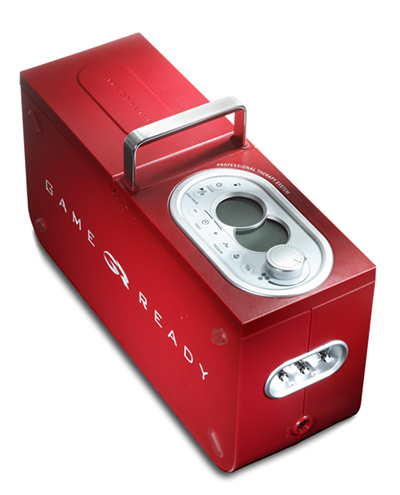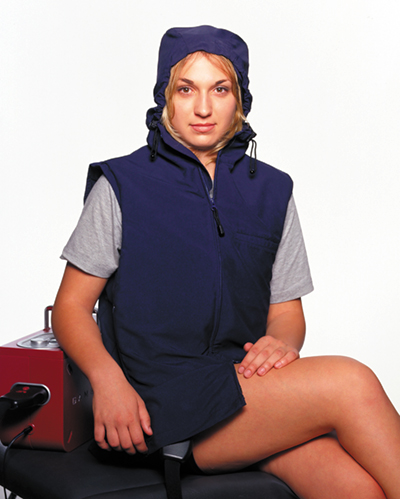Gearing Up for the Big Game...and More
Originating Technology/NASA Contribution
Honored as an inductee of the U.S. Space Foundation’s Space Technology Hall of Fame and recognized by the American Astronautical Society as “one of the true fathers of the space suit,” Bill Elkins spent years conducting extensive research on clothing technology for hostile environments while he served as a NASA contractor at Ames Research Center. During the Apollo era, Elkins assisted Ames investigators in the development of a liquid-cooled garment to protect astronauts from extreme temperatures on the Moon. The garment successfully maintained the astronauts’ body temperatures at a comfortable level by utilizing a battery-powered mini-pump to circulate chilled water through a network of tubes lining the garment.
Partnership
As a holder of 19 patents covering inventions in restraint, space suit components, heat transfer, solar energy conversion, food preservation, and medical equipment, Elkins founded CoolSystems, Inc., based on his revolutionary findings that space suit technology could treat athletic injuries and offer therapeutic benefits to those who suffer from Multiple Sclerosis (MS). The products manufactured by CoolSystems are directly spun from the liquid-cooled garments worn by NASA astronauts.
Product Outcome
After years of collaboration with NASA, Elkins began working with sports trainers and doctors in 1998 to expand his discoveries into the realm of sports medicine. Early prototypes of his research were tested and met with glowing reviews from professional trainers and world-class athletes, such as National Football League Pro Bowl wide receiver and future Hall of Famer Jerry Rice. CoolSystems came together in 2000 as Elkins and his primary investors, The Roda Group, assembled a management team of executives, athletes, and engineers with extensive expertise in building flourishing sports brands. Tom Oliver, CoolSystems president and chief executive officer, was hired in May 2000 to bring the technology to market.
In June 2002, the CoolSystems team introduced its first product, the Game Ready™ Accelerated Recovery System, which combines space suit technology, medical research, and sports savvy to speed up the healing of athletic and post-operative injuries. Using patented ergonomic wraps and an adjustable control unit, the Game Ready Accelerated Recovery System is the first sports therapy product on the market to simultaneously provide deep tissue cooling therapy and intermittent compression, according to the company.
The seven ergonomic wraps, made from flexible fabric and designed to custom fit the ankle, knee, back, torso, shoulder, elbow, and wrist, effectively reduce pain, swelling, and tissue damage. They can be applied firmly and securely to injured areas, using hook and loop fasteners. The control unit connected to a wrap is filled with ice and water, so that cooled water can be circulated through the wrap over the course of treatment. The control unit additionally features microprocessors that control treatment time, temperature, and the level of intermittent compression that is being applied to the injured area.
When treating athletic and post-operative injuries, trainers and doctors follow the “RICE” (rest, ice, compression, elevation) formula. Although the RICE method is universally accepted, it can cause more harm than good when not applied properly. For instance, icing down an injury for too long or at too cold of a temperature can potentially cause further tissue damage (“freezer burn” is a term commonly associated with the overuse of ice packs). With the Game Ready system, athletes or injured individuals are subjected to controlled cold therapy within the optimum temperature range to maximize effectiveness and help prevent additional tissue damage.
The correct amount of compression is also difficult to calculate when properly implementing the RICE regimen. The Game Ready system provides “cyclical” compression, which has been shown to be superior to the “static” compression offered by other products and traditional therapies such as elastic bandages and cold wraps. Cyclical compression is preferable to static compression as it more closely mirrors the muscle contractions that the body itself uses to force tissue debris out of the affected area. In addition, with cyclical compression there is no known danger of restricting the body’s natural efforts to evacuate excess fluid.
The Game Ready technology also offers convenience for its users. The complete kit is portable and can operate off of a battery pack, so it can be used on the field, in the car, on the bus, or on an airplane. Because the system is easier to apply, more comfortable, and less messy than ice packs, athletes and patients are more likely to comply with their rehabilitation programs.
Professional trainers using the Game Ready system report that they consistently see their athletes’ recovery times cut in half from what they would expect for the injuries they commonly treat. Stan Conte, trainer for Major League Baseball’s San Francisco Giants, is one of the trainers who have had newfound success in getting players back on the field. “I’ve seen a two-fold increase in recovery rates,” Conte claims. “Guys that normally would have been out for a week are back in half the time.” Today, more than 60 professional sports teams (including the Green Bay Packers, New England Patriots, Philadelphia Flyers, Boston Bruins, Atlanta Hawks, and the Sacramento Kings), 70 universities, and nearly 200 individual professional athletes (including Warren Sapp of the Oakland Raiders and Corey Maggette of the Los Angeles Clippers) have purchased Game Ready systems. In addition, the U.S. Olympic Training Centers, Navy SEALs, and the San Francisco Ballet have latched on to the new cooling technology.
While the Game Ready Accelerated Recovery System is getting plenty of use in the world of sports, the CoolSystems team has introduced a sister product that is getting an abundance of attention off the field. The Recharge™ Active Cooling System reduces core body temperature, which can alleviate the symptoms associated with MS and other neurological disorders. Employing the same space suit ingenuity that offers precise temperature and pressure control within a flexible garment for astronauts and the same cooling principles of the Game Ready product, the Recharge system is comprised of a hooded vest that attaches to a control unit when cooling is required. The garment features a hidden cooling function so that it looks like ordinary outerwear when disconnected from the control unit.
The effectiveness of the Recharge system extends to athletes at risk for heat exhaustion or heat stroke as a result of physical exertion or exercise in high-temperature environments, as well as those who suffer from other heat-related neurological disorders. The hooded cooling vest will quickly and safely lower core body temperature in such extreme conditions.
Individuals suffering from MS and other neurological disorders are reaping benefits from the Recharge system in the form of long-lasting relief. The heat-induced symptoms of MS manifest themselves in a variety of ways, from increased fatigue and decreased balance, vision, strength, and endurance, to total body “shutdown.” In an individual with heat-sensitive MS, the elevation of core body temperature above that person’s normal baseline temperature—as may be caused by exercise or hot weather—can result in the onset or worsening of the symptoms. A NASA study published in the June 2003 edition of the journal Neurology shows that if these individuals can keep their core body temperatures at or below their baseline temperatures, many of the symptoms of the disease can be reduced.
Keeping core body temperature near baseline is a challenge, however. Methods such as cool baths, ice vests, or the provision of highly air-conditioned environments have been used to keep the body temperatures of those with MS down, but most of these methods are difficult to integrate into a normal routine. Recharge has been developed as a portable, convenient, and easy-to-use tool to enable people with MS to keep themselves cool wherever they are, even hours after a cooling session.
In February 2004, CoolSystems announced that it had entered into a collaboration agreement to test a “next-generation” cooling helmet with the Stanford University Medical Center’s Stanford Stroke Center, which was recently acknowledged in a University Health Consortium survey as the leading academic institution in the country for stroke management, based on 20 different measures of patient outcome. The collaboration will further investigate the effectiveness of discrete hypothermia in stroke and head trauma patients.
Game Ready™ and Recharge™ are trademarks of CoolSystems, Inc.
Previous Page | Home | Contents | Next page

Where cold packs and ice packs offer limited flexibility, Game Ready’s advanced injury treatment system allows you to control temperature and levels of compression

The Recharge™ Active Cooling System is designed to enable users to lower core body temperature to effectively manage the symptoms of Multiple Sclerosis or other heat-related neurological disorders













